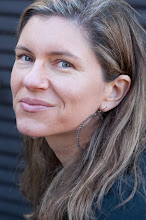Yesterday I joined mystic Rebecca Burgess and herbalist Cheryl Fromholzer as they pioneered the emerging yet ancient field (love that!) of medicinal dyes for our clothes in a local workshop. entitled "Healing Clothes: Making Dyes & Natural Medicine." Ancient because it's been done for 2500+ years, mostly documented in the Ayurvedic tradition. Modern because it's low carbon footprint, super-eco and, well, sexy. Above is a dress by a New York designer named a.d.o. clothing that Rebecca introduced me to - herb-dyed in indigo, organic loveliness. As used in the dress above, we worked with indigo, madder root, turmeric, nettle, rosemary and fennel.
I noted during the workshop that nearly all the medicinal properties of the dyes we discussed included lymphatic cleansers. Hello? Doesn't that make sense in some higher order system that what we wear against our skin would also work on the system immediately beneath our skin, namely the lymph that scours our cells, seeking the bad guys, turning them out, sending all the fluid love back to the heart? We all need a rigorous lymphatic system, as that keeps us taut and pert (we, the women of 40+, particularly need this).
Why does working and learning from Rebecca make me so happy? I have a few ideas: perhaps it's her charisma and buoyant energy. Always good to surround oneself with people like this. Perhaps it's her naturally-dyed clothes offering: a gorgeous alternative to the conventional, toxic clothing world. Or her way of educating us to lessen our carbon footprint in a way that feels accessible and less sanctimonious than, say, riding a bike to work (how do I do that with 2 kids to drive to school 5 and 10 miles away?).
Rebecca lives a radical concept: wear clothing from within 150 miles for one year. She is a mystic from another world, as many of you know from my previous posts. We've hosted her here in Oakland a few times previously. Check out her Fibershed Project right here. Oh, and what could be better than her explaining it herself....
Gathering Thyme is a gorgeous space in San Anselmo. Cheryl is a co-founder and opened her beautiful space last October. We sat in a circle, talking about the medicinal properties of the luscious colors we were to use that day in our dye baths, including....
- Turmeric - our most potent anti-inflammatory. Rebecca chatted about the ancient Ayurvedic tradition of wearing robes dyed in turmeric for skin disorders or for obstinate bladder infections, and sleeping on turmeric sheets. Sounds far better to me than sleeping on flame retardants. Cheryl taught us about how it protects the liver as well. Take as a capsule, sprinkle turmeric powder on your food or sleep on turmeric-infused sheets. Rebecca talked about drinking turmeric drinks while traveling in Bali.
- Next came Madder Root. Just damn pretty, let alone powerful at dissolving kidney stones and getting rid of parasites.
- Indigo was the third feature. In Ayurveda, indigo was used to help people become more conscious, to treat a condition called "moha," or unconsciousness. In other words, indigo opens the upper chakras and opens your reality. Also used for preventing malaria or any mosquito-borne disease - folks would wear silk dyed in indigo.
Charlotte, who assisted Rebecca, made a lovely prayer flag out of the dyes we used today. Each swatch below is a different natural fiber such as silk, hemp/cotton, raw silk. I'll end with that.








3 comments:
it seems to me that if you [or Rebecca] were going to be true to the 150 mile limit, then using imported dyes, especially ones like tumeric that are intended for use in food in small quantities [rather than the quantities required to make up a dyepot] would be out of the question.
while i can't limit my 'clothing radius' unless i rework stuff from the thrift store or wear clothes made from the wool of my own sheep [a bit tricky because the DO have a prickle factor and i'm overly sensitive] - as far as dyeing goes i'm a firm believer in bio-regional windfall dyes.
this means using stuff that grows where i happen to be working, either in the form of windfalls or as harvested weeds [that means weeds that are not native to the area and are proclaimed by authorities as plants needing removal due to their ecological impact]
i think it's important to check the background of imported dyestuffs - for example logwood [source of beautiful purples] requires the cutting down of an entire tree, as the colour comes from the heartwood.
this comment, by the way, is not intended to be critical of you or Rebecca, just trying to be helpful. [and adding this footnote in case my contribution seems a tad abrupt]
best wishes
india
My small Oregon clothing company, Tinctoria, makes timeless, comfortable designs for women. Our line is organic and dyed with natural plant dyes. Check us out at www.tinctoriadesigns.com.
Thanks for your comment, India. The purpose of the workshop I featured was to cover medicinal dyes, not bioregional dyes. Apologies if I wasn't clear about that. We all love your work with windfall dyes. Appreciate your thoughts and participation. Sara
Post a Comment